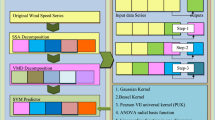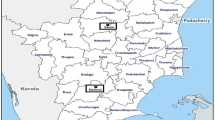Abstract
The aims of this study are to develop a novel compound structure that consists of two-stage decomposition (TSD), hybrid particle swarm optimization gravitational search algorithm (HPSOGSA) and multi-kernel least square support vector machine (MLSSVM) for improving forecasting accuracy. In the most previous wind speed forecasting studies, only one wind speed signal decomposition method is considered, which is insufficient. To better deal with the wind speed time series, TSD method combining complementary ensemble empirical mode decomposition with adaptive noise with wavelet transform is firstly employed in the proposed model to preprocess the wind speed samples; then, binary-valued particle swarm optimization gravitational search algorithm is exploited as feature selection to identify and eliminate the abnormal noise signal within the input candidate matrix that is determined by partial autocorrelation function. The kernel function and the kernel parameters have great influence on the regression performance of LSSVM. To solve these problems, integrations of radial basis function, polynomial (poly) and linear kernel functions by optimal weighted coefficients are constructed as multi-kernel function for LSSVM, namely MKLSSVM, and the parameter combination is tuned by conventional PSOGSA. The feature selection and parameter optimization are realized by hybrid PSOGSA (HPSOGSA) simultaneously. Finally, comprehensive comparison and analysis are carried out using the historical wind speed data from one wind farm of China to illustrate the excellent forecasting performance of TSD–HPSOGSA–MKLSSVM.











Similar content being viewed by others
References
Aghajani A, Kazemzadeh R, Ebrahimi A (2016) A novel hybrid approach for predicting wind farm power production based on wavelet transform, hybrid neural networks and imperialist competitive algorithm. Energy Convers Manag 121:232–240
Bouzgou H, Benoudjit N (2011) Multiple architecture system for wind speed prediction. Appl Energy 88:2463–2471
Dong QL, Sun YH, Li PZ (2017) A novel forecasting model based on a hybrid processing strategy and an optimized local linear fuzzy neural network to make wind power forecasting: A case study of wind farms in China. Renew Energy 102:241–257
Du P, Wang JZ, Guo ZH et al (2017) Research and application of a novel hybrid forecasting system based on multi-objective optimization for wind speed forecasting. Energy Convers Manag 150:90–107
Feng C, Cui MJ, Hodge B et al (2017) A data-driven multi-model methodology with deep feature selection for short-term wind forecasting. Appl Energy 190:1245–1257
Han T, Liu QN, Zhang L et al (2019) Fault feature extraction of low speed roller bearing based on Teager energy operator and CEEMD. Measurement 138:400–408
Haque AU, Mandal P, Meng J et al (2013) A novel hybrid approach based on wavelet transform and fuzzy ARTMAP networks for predicting wind farm power production. IEEE Trans Ind Appl 49:2253–2261
Hemmati-Sarapardeha A, Varameshb A, Huseinc M et al (2018) On the evaluation of the viscosity of nanofluid systems: modeling and data assessment. Renew Sustain Energy Rev 81:313–329
Hu JM, Wang JZ, Ma KL (2015) A hybrid technique for short-term wind speed prediction. Energy 81:563–574
Kumar L, Krishna Sripada S, Surekac A et al (2018) Effective fault prediction model developed using least square support vector machine (LSSVM)”. J Syst Softw 137:686–712
Li HM, Wang JZ, Lu HY et al (2018) Research and application of a combined model based on variable weight for short term wind speed forecasting. Renew Energy 116:669–684
Liu D, Niu D, Wang H et al (2014) Short-term wind speed forecasting using wavelet transform and support vector machines optimized by genetic algorithm. Renew Energy 62:592–597
Liu JQ, Wang XR, Lu Y (2017) A novel hybrid methodology for short-term wind power forecasting based on adaptive neuro-fuzzy inference system. Renew Energy 103:620–629
Liu TH, Wei HK, Zhang KJ (2018) Wind power prediction with missing data using Gaussian process regression and multiple imputation. Appl Soft Comput 71:905–916
Luo M, Li CS, Zhang XY et al (2016) Compound feature selection and parameter optimization of ELM for fault diagnosis of rolling element bearings. ISA Trans 65:556–566
Mirjalili S, Hashimx S (2012) A new hybrid PSOGSA algorithm for function optimization. In: International conference on computer and information application, pp 374–377
Naik J, Dash S, Dash PK et al (2018) Short term wind power forecasting using hybrid variational mode decomposition and multi-kernel regularized pseudo inverse neural network. Renew Energy 118:180–212
Osorio GJ, Matias JCO, Catalao JPS (2015) Short-term wind power forecasting using adaptive neuro-fuzzy inference system combined with evolutionary particle swarm optimization, wavelet transform and mutual information. Renew Energy 75:301–307
Peng T, Zhou JZ, Zhang C et al (2017) Multi-step ahead wind speed forecasting using a hybrid model based on two-stage decomposition technique and AdaBoost-extreme learning machine. Energy Convers Manag 153:589–602
Rashedi E, Nezamabadi S, Saryazdi S (2009) GSA: a gravitational search algorithm. Inform Sci 179:2232–2248
Rostami S, Rashidi F, Safari H (2019) Prediction of oil-water relative permeability in sandstone and carbonate reservoir rocks using the CSA-LSSVM algorithm. J Petrol Sci Eng 173:170–186
Salcedo-Sanz S, Pastor-Sanchez A, Prieto L et al (2014) Feature selection in wind speed prediction systems based on a hybrid coral reefs optimization-extreme learning machine approach. Energy Convers Manag 87:10–18
Santamaria-Bonfil G, Reyes-Ballesteros A, Gershenson C (2016) Wind speed forecasting for wind farms: A method based on support vector regression. Renew Energy 85:790–809
Stephen JE, Kumar SS, Jayakumar J (2014) Nonlinear modeling of a switched reluctance motor using LSSVM-ABC. Acta Polytech Hung 11:143–158
Sun SZ, Fu JQ, Zhu F (2018a) A hybrid structure of an extreme learning machine combined with feature selection, signal decomposition and parameter optimization for short-term wind speed forecasting. Trans Inst Meas Control 40:1–18
Sun SZ, Fu JQ, Zhu F, Xiong N (2018b) A compound structure for wind speed forecasting using MKLSSVM with feature selection and parameter optimization. Math Probl Eng 9287097(11):1–21
Sun GP, Jiang CW, Cheng P et al (2018c) Short-term wind power forecasts by a synthetical similar time series data mining method. Renew Energy 115:575–584
Sun SZ, Wei LS, Xu J et al (2019) A new wind power forecasting modeling strategy using two-stage decomposition, feature selection and DAWNN. Energies 12334:1–24
Torres ME, Colominas MA, Schlotthauer G et al (2011) A complete ensemble empirical mode decomposition with adaptive noise. In: 2011 IEEE international conference on acoustics, speech and signal processing (ICASSP), pp 4144–4147
Wang Y, Wang JZ, Wei X (2015a) A hybrid wind speed forecasting model based on phase space reconstruction theory and Markov model: A case study of wind farms in northwest China. Energy 91:556–572
Wang Y, Wang JZ, Wei X (2015b) A hybrid wind speed forecasting model based on phase space reconstruction theory and Markov model: A case study of wind farms in northwest China. Energy 91:556–572
Wang SX, Zhang N, Wu L et al (2016) Wind speed forecasting based on the hybrid ensemble empirical mode decomposition and GA-BP neural network method. Renew Energy 94:629–36
Wang DY, Luo HY, Grunder O et al (2017) Multi-step ahead wind speed forecasting using an improved wavelet neural network combining variational mode decomposition and phase space reconstruction. Renew Energy 113:1345–1358
Wu Z, Huang NE (2009) Ensemble empirical mode decomposition: a noise-assisted data analysis method. Adv Adaptive Data Anal 1:1–41
Yan J, Huang GQ, Peng XY et al (2018) A novel wind speed prediction method: hybrid of correlation-aided DWT, LSSVM and GARCH. J Wind Eng Ind Aerod 174:28–38
Yin H, Dong Z, Chen YL et al (2017) An effective secondary decomposition approach for wind power forecasting using extreme learning machine trained by crisscross optimization. Energy Convers Manag 150:108–121
Yuan XH, Chen C, Yuan YB et al (2015) Short-term wind power prediction based on LSSVM-GSA model. Energy Convers Manag 101:393–401
Zhang GY, Wu YG, Liu YQ (2014) An advanced wind speed multi-step ahead forecasting approach with characteristic component analysis. J Renew Sustain Energy 053139(6):1–14
Zhang C, Wei HK, Zhao JS et al (2016a) Short-term wind speed forecasting using empirical mode decomposition and feature selection. Renew Energy 96:727–737
Zhang C, Wei HK, Zhao JS et al (2016b) Short-term wind speed forecasting using empirical mode decomposition and feature selection. Renew Energy 96:727–737
Zhang C, Zhou JZ, Li CS et al (2017) A compound structure of ELM based on feature selection and parameter optimization using hybrid backtracking search algorithm for wind speed forecasting. Energy Convers Manag 143:360–376
Zheng H, Liao R, Grzybowski S et al (2011) Fault diagnosis of power transformers using multi-class least square support vector machines classifiers with particle swarm optimization. IET Electr Power Appl 5:691–696
Zheng WQ, Peng XG, Lu D et al (2017) Composite quantile regression extreme learning machine with feature selection for short-term wind speed forecasting: A new approach. Energy Convers Manag 151:737–752
Zhou JY, Shi J, Li G (2011) Fine tuning support vector machines for short-term wind speed forecasting. Energy Convers Manag 52:1990–1998
Acknowledgements
This work was supported by the Key Laboratory of Electric Drive and Control of Anhui Higher Education Institutes, Anhui Polytechnic University (DQKJ202003); the Projects of Science and Technology Commission of Shanghai Municipality (Grant No. 15JC1401900 and No.17511107002); the National Natural Youth Fund Project (Grant No. 61803001); the Open Research Fund of Wanjiang Collaborative Innovation Centerfor High-end Manufacturing Equipment, Anhui Polytechnic University (Grant No. GCKJ2018010); and the Natural youth fund project of Anhui Province (Grant No.1808085QF194).
Author information
Authors and Affiliations
Corresponding author
Ethics declarations
Conflict of interest
There is no conflict of interest exiting in the submission of this manuscript which has been approved by all authors for publication, and there is no information that might be relevant for the editors and reviewers of soft computing. This study develops a new wind speed forecasting model using two-stage signal decomposition, hybrid PSOGSA algorithm and multi-kernel LSSVM. This article does not contain any studies with human participants performed by any of the authors. This article also does not contain any studies with animals performed by any of the authors. I would like to declare on behalf of my co-authors that the work described is original research that has not been published previously, and not under consideration for publication elsewhere, in whole or in part.
Additional information
Communicated by V. Loia.
Publisher's Note
Springer Nature remains neutral with regard to jurisdictional claims in published maps and institutional affiliations.
Appendix
Appendix
All abbreviations are collected, and a brief explanation is given in Table 11.
Rights and permissions
About this article
Cite this article
Sun, S., Fu, J., Li, A. et al. A new compound wind speed forecasting structure combining multi-kernel LSSVM with two-stage decomposition technique. Soft Comput 25, 1479–1500 (2021). https://doi.org/10.1007/s00500-020-05233-8
Published:
Issue Date:
DOI: https://doi.org/10.1007/s00500-020-05233-8




